Denial Code PR 27: An Ultimate Guide
Let’s take a look at a common claim denial, denial code PR 27. Let’s talk about what this code means, how to prevent it, and how to address it.

According to AAFP, keeping your denial rate below 5% is advisable. However, this is often easier said than done. Experts often describe the medical billing process as complicated...and this is putting it nicely. I’m sure if you are in medical billing and coding, you have your word for it.
No matter how frustrating it can be, knowing the ins and outs is essential when it comes to turning a profit. Your financial health relies on all tasks running smoothly within your revenue cycle.
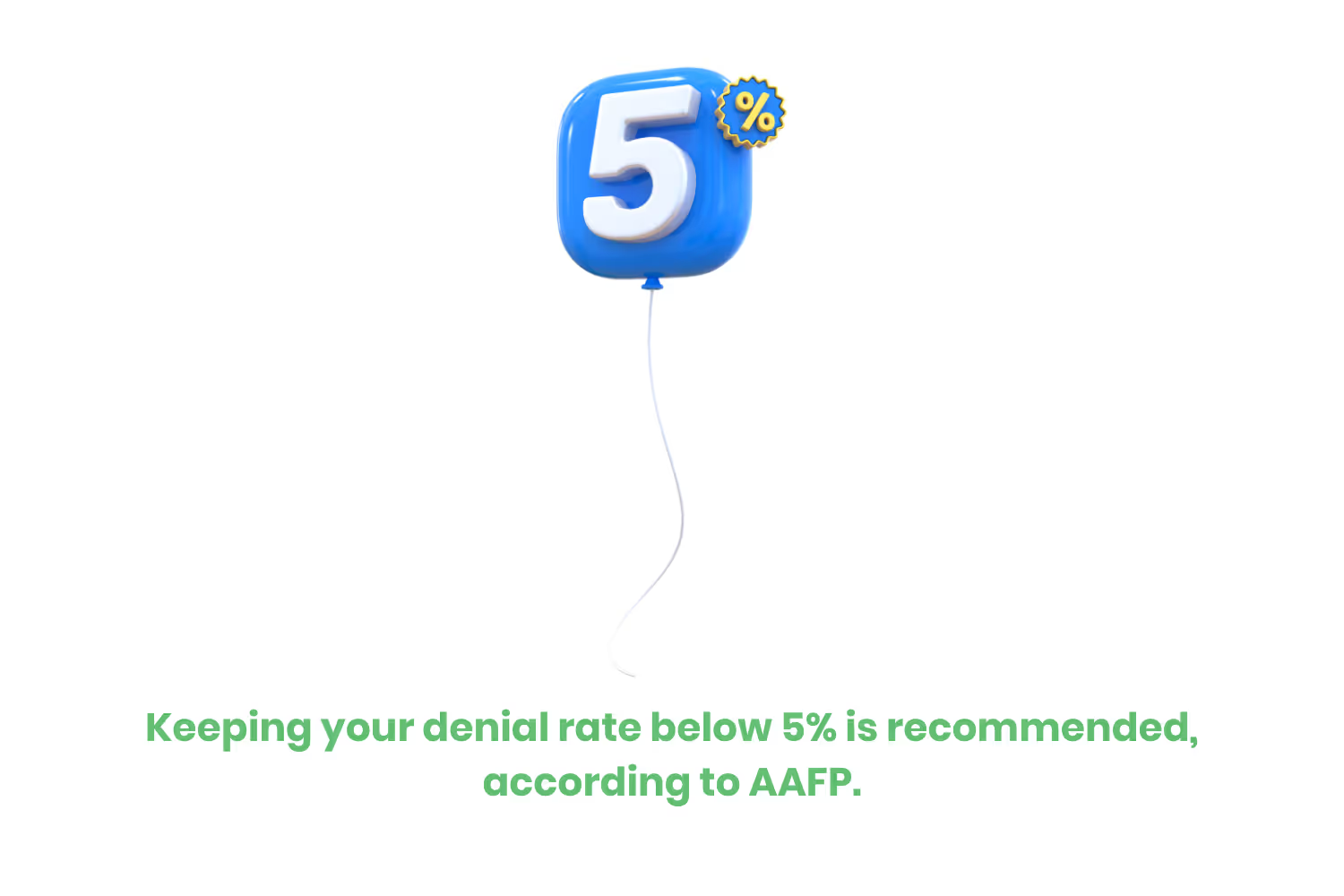
Navigating this department unscathed by roadblocks isn’t possible, unfortunately. But reducing the rate of errors is. Claim denials notoriously throw a monkey wrench into billing practices. Claim denials damage the overall function of a business, affecting not only the financial health of your company but also draining resources and employee time.
So, how do you avoid a slew of denial codes from bottlenecking your revenue cycle? How can you address them with accurate interpretation along with prompt action taken? Educating your team and prioritizing administration efficiency is the place to start.
We will get into more specifics on other tips to reduce denial codes later. For now, let’s take a look at a common claim denial, denial code PR 27. Let’s talk about what this code means, how to prevent it, and how to address it.
About Denial Codes
Quickly, before we get into the specifics of PR 27, let’s go over some denial code basics. These codes are key when it comes to indicating why payers deny healthcare service reimbursement. They include a standardized message from the insurance company. Throughout the healthcare industry, no matter the insurance company, you can count on these codes to stay the same.
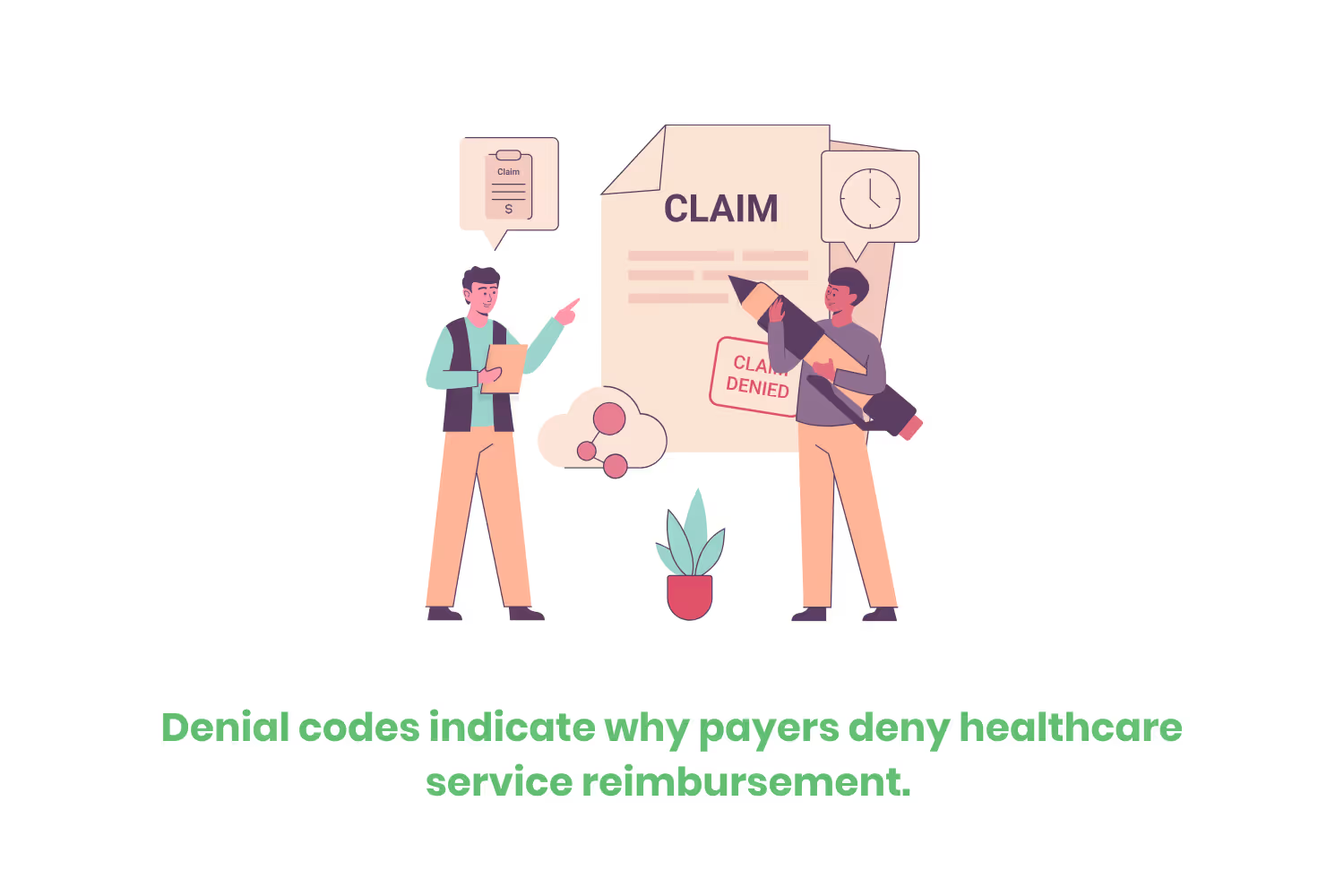
Knowing these codes, or at least the most common ones, can help you avoid revenue loss. This enables your team to collect claims faster and with less employee labor. Avoid administrative inefficiencies and ensure optimal financial performance by staying up to date with industry standards. Let’s talk about denial code PR 27 as one of the more common denial codes.
Denial Code PR 27
If you receive denial code PR 27, the first thing you need to do is figure out what it even stands for. Insurance companies send these denial codes to healthcare providers who incur expenses for a service or treatment after a patient’s coverage is over. The PR stands for “Patient Responsibility”. When you see this abbreviation preceding a denial code, you know that it is the patients who are in charge of paying the expenses. Expenses may include things such as copays or deductibles.
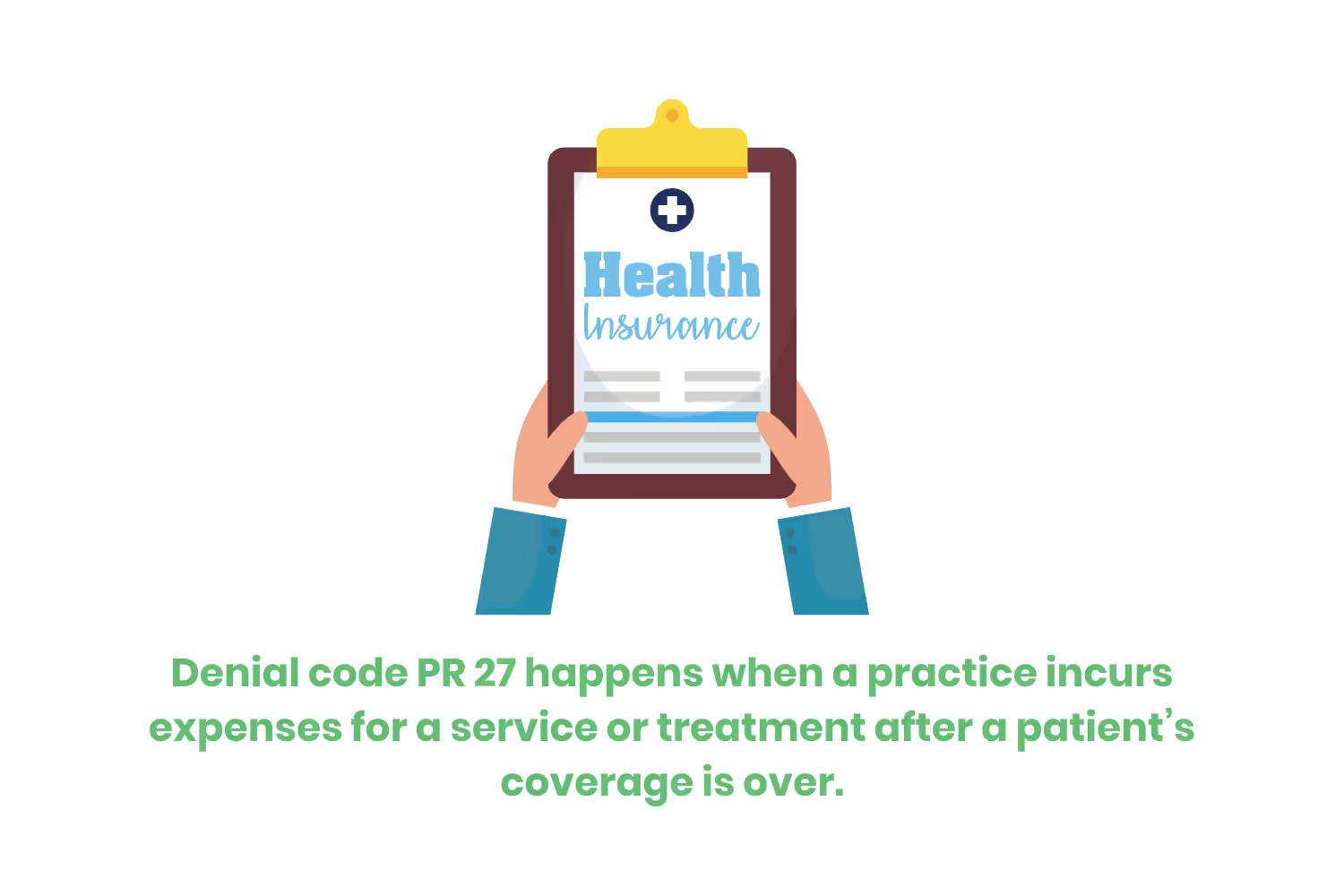
As with any other denial code, there are many different causes that may lead to receiving PR 27. Let’s go over a few of the most common examples as to why your billing team might encounter this error.
Common Causes of Denial Code PR 27
First, failing to update a patient’s insurance information before they receive services can cause this error. When a patient’s coverage ends, you should follow up with them to discuss any new plans or alternative coverage they will use. You don’t want to continue billing to their old insurance plan! Remember, billing to services after the coverage termination date passes can result in receiving denial code 27.
Another common cause for denial code 27 comes from delays in submitting claims. Healthcare providers and their billing teams may not always have their claims entered in a timely fashion. If this is the case, and you end up submitting a claim to the payer after the patient’s coverage termination date, you will likely receive this denial code.
Make sure to keep open communication with your patients. Let’s circle back to what happens when you don’t update a patient’s insurance information. I already emphasized the importance of keeping up to date with patients’ payer coverage.
But if a patient doesn’t disclose that their coverage has been terminated, how are you supposed to know to not bill it? How can you possibly have the right insurance information if discourse between your billing team and your patients doesn’t exist?
Make sure to regularly ask if patients still have the same insurance. If they don’t, be sure to grab the new insurance information before they receive their next services.

Finally, keep a lookout for common billing errors. These might include incorrect dates or general coding errors. An unrelated billing error could cause a claim to be returned multiple times, which could be detrimental.
These errors might take too long to fix.
By the time you do successfully send the claim, you run the risk of submitting it after insurance coverage ends Resulting in denial code PR 27.
All providers must consider these common causes into consideration when it comes to minimizing their claim denials. This will only help healthcare organizations implement better revenue cycle management practices and help to better streamline administrative duties.
Ensuring timely reimbursement for services rendered, as well as sustainable financial health, starts with minimizing your claim denial rate.
How to Address Denial Code PR 27
So you took all of the steps to make sure that you would not run into denial code PR 27… but you still get one back. No worries! We can’t win them all, right?
There are some steps you can take after receiving this denial to fix or mitigate it. First off, double-check the patient’s insurance coverage termination date. You want to see when exactly this coverage ended, and when the provider rendered their services. To find the termination date, check the patient’s insurance policy. You can also contact their insurance provider directly.
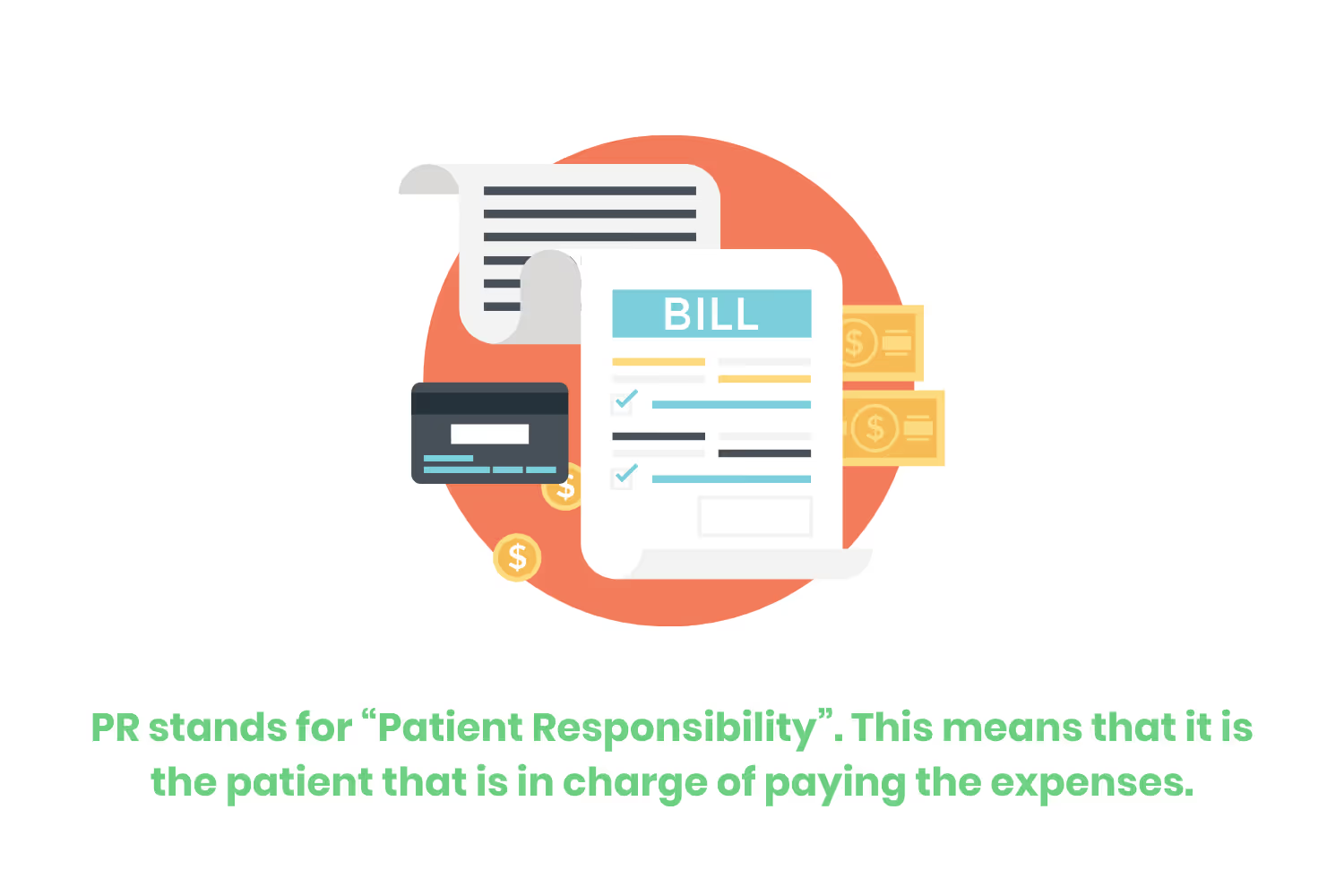
Double-check that the services in question were performed on the date documented. If there was a billing error, and the date of service was before the termination date, you can appeal the claim. You can also submit an appeal to the insurance company if you believe the denial is incorrect or unjustified in other ways. Just make sure to include all of the necessary documentation to back up your appeal.
While you navigate this claim denial, make sure to keep your patient in the loop. Communication with your patient to discuss the situation may provide useful information that you need. If the denial code PR 27, then it is time to discuss with your patient about payment options. Through everything, make sure to document all of the steps taken.
How to Prevent Denial Code PR 27
They say prevention is the best medicine. Who is ‘they’ in this scenario? I’m not sure, but you’ve heard the saying, so don’t get smart with me. If you haven’t heard the saying, allow me to apologize. That wasn’t directed at you. Essentially, we are talking about how taking action to avoid a problem is better than having to deal with the problem at all.
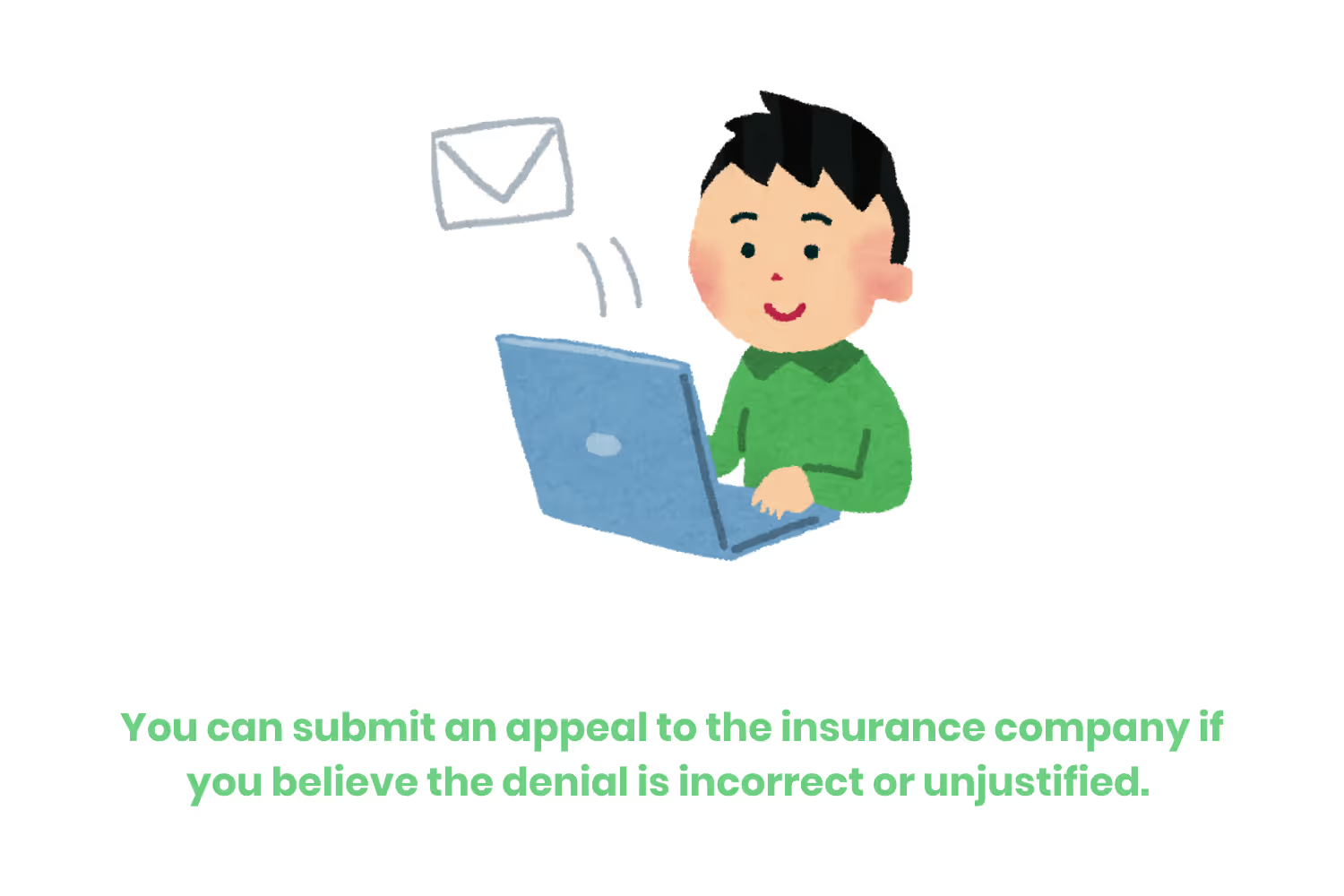
Here are some tips on how to go about preventing this denial code:
- Ensure timely verification of your patient’s insurance coverage. Make sure to do this before providing services to determine any lapses in coverage.
- Communicate with your patients! When there are changes to your patient’s insurance coverage, encourage them to keep an open line of communication with you about it.
- Conduct regular audits and reviews of claims and billing processes.
- Use technological solutions to automate insurance coverage verifications. Solutions, such as revenue cycle management software, help enhance your process efficiency.
- Understand any changes in coverage termination rules by staying informed about the latest payer policies.
- Keep your staff educated on insurance coverage and why it is important to verify before providing services.
Adopting these strategies will help your billing team reduce the amount of PR 27 claim denials you see in a day. Therefore, enhancing your revenue cycle management processes and collecting payments faster.
Conclusion
Navigating the intricacies of the medical billing process, like understanding claim denials, takes time and patience. However, it is essential for maintaining good financial health and keeping your revenue cycle management running smoothly. As I said before, you can’t win all of your battles, however. It is impossible to avoid all claim denials. However, minimizing administrative errors can save your team from easily avoidable denials such as PR 27.
Through different practices, such as employee education and keeping open communication with your patients, you can reduce the occurrence rate of claim denials. Streamline your administrative tasks, enhance your profitability, and reinforce the overall stability and efficiency of your organization with these proactive measures.
Emphasize your product's unique features or benefits to differentiate it from competitors
In nec dictum adipiscing pharetra enim etiam scelerisque dolor purus ipsum egestas cursus vulputate arcu egestas ut eu sed mollis consectetur mattis pharetra curabitur et maecenas in mattis fames consectetur ipsum quis risus mauris aliquam ornare nisl purus at ipsum nulla accumsan consectetur vestibulum suspendisse aliquam condimentum scelerisque lacinia pellentesque vestibulum condimentum turpis ligula pharetra dictum sapien facilisis sapien at sagittis et cursus congue.
- Pharetra curabitur et maecenas in mattis fames consectetur ipsum quis risus.
- Justo urna nisi auctor consequat consectetur dolor lectus blandit.
- Eget egestas volutpat lacinia vestibulum vitae mattis hendrerit.
- Ornare elit odio tellus orci bibendum dictum id sem congue enim amet diam.
Incorporate statistics or specific numbers to highlight the effectiveness or popularity of your offering
Convallis pellentesque ullamcorper sapien sed tristique fermentum proin amet quam tincidunt feugiat vitae neque quisque odio ut pellentesque ac mauris eget lectus. Pretium arcu turpis lacus sapien sit at eu sapien duis magna nunc nibh nam non ut nibh ultrices ultrices elementum egestas enim nisl sed cursus pellentesque sit dignissim enim euismod sit et convallis sed pelis viverra quam at nisl sit pharetra enim nisl nec vestibulum posuere in volutpat sed blandit neque risus.

Use time-sensitive language to encourage immediate action, such as "Limited Time Offer
Feugiat vitae neque quisque odio ut pellentesque ac mauris eget lectus. Pretium arcu turpis lacus sapien sit at eu sapien duis magna nunc nibh nam non ut nibh ultrices ultrices elementum egestas enim nisl sed cursus pellentesque sit dignissim enim euismod sit et convallis sed pelis viverra quam at nisl sit pharetra enim nisl nec vestibulum posuere in volutpat sed blandit neque risus.
- Pharetra curabitur et maecenas in mattis fames consectetur ipsum quis risus.
- Justo urna nisi auctor consequat consectetur dolor lectus blandit.
- Eget egestas volutpat lacinia vestibulum vitae mattis hendrerit.
- Ornare elit odio tellus orci bibendum dictum id sem congue enim amet diam.
Address customer pain points directly by showing how your product solves their problems
Feugiat vitae neque quisque odio ut pellentesque ac mauris eget lectus. Pretium arcu turpis lacus sapien sit at eu sapien duis magna nunc nibh nam non ut nibh ultrices ultrices elementum egestas enim nisl sed cursus pellentesque sit dignissim enim euismod sit et convallis sed pelis viverra quam at nisl sit pharetra enim nisl nec vestibulum posuere in volutpat sed blandit neque risus.
Vel etiam vel amet aenean eget in habitasse nunc duis tellus sem turpis risus aliquam ac volutpat tellus eu faucibus ullamcorper.
Tailor titles to your ideal customer segment using phrases like "Designed for Busy Professionals
Sed pretium id nibh id sit felis vitae volutpat volutpat adipiscing at sodales neque lectus mi phasellus commodo at elit suspendisse ornare faucibus lectus purus viverra in nec aliquet commodo et sed sed nisi tempor mi pellentesque arcu viverra pretium duis enim vulputate dignissim etiam ultrices vitae neque urna proin nibh diam turpis augue lacus.




